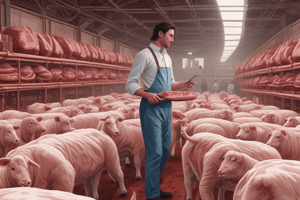Podcast
Questions and Answers
What percentage of foodborne disease cases are associated with temperature abuse?
What percentage of foodborne disease cases are associated with temperature abuse?
- 20%
- 40%
- 30%
- 50% (correct)
Why are infants, the elderly, and people who are ill more susceptible to foodborne pathogens?
Why are infants, the elderly, and people who are ill more susceptible to foodborne pathogens?
- They have a higher resistance to pathogens
- They have a lower resistance to pathogens (correct)
- They have a stronger immune system
- They are less likely to wash their hands
What is the minimum core temperature that meat should be heated to for 2 minutes to prevent foodborne disease?
What is the minimum core temperature that meat should be heated to for 2 minutes to prevent foodborne disease?
- 70°C (correct)
- 65°C
- 75°C
- 80°C
Why is it important to wash hands before and after handling raw meat?
Why is it important to wash hands before and after handling raw meat?
What can significantly lower a person's resistance to foodborne pathogens?
What can significantly lower a person's resistance to foodborne pathogens?
Why should raw meat be stored in small containers in refrigerators?
Why should raw meat be stored in small containers in refrigerators?
What is the primary source of microorganisms in the deep muscle tissues of healthy, slaughtered livestock?
What is the primary source of microorganisms in the deep muscle tissues of healthy, slaughtered livestock?
What should not come into contact with cooked or ready-to-eat foods?
What should not come into contact with cooked or ready-to-eat foods?
What is the main reason for bacterial load on the surfaces of the carcass during meat production?
What is the main reason for bacterial load on the surfaces of the carcass during meat production?
Why is it important to clean the raw meat preparation area before and after cooking?
Why is it important to clean the raw meat preparation area before and after cooking?
Where do microorganisms come from during the processing of meat?
Where do microorganisms come from during the processing of meat?
What is the purpose of controlling contamination opportunities during meat production?
What is the purpose of controlling contamination opportunities during meat production?
What is the recommended standard for meat with a good shelf-life?
What is the recommended standard for meat with a good shelf-life?
What is the main method of controlling contamination during meat production?
What is the main method of controlling contamination during meat production?
What is the primary reason for the removal of skin during meat production?
What is the primary reason for the removal of skin during meat production?
What is the significance of the gastro-intestinal tract in meat production?
What is the significance of the gastro-intestinal tract in meat production?
What is the approximate number of organisms found per cm2 of hide on live cattle?
What is the approximate number of organisms found per cm2 of hide on live cattle?
Why is it important to remove hides or fleece in a manner that avoids contact with the carcass?
Why is it important to remove hides or fleece in a manner that avoids contact with the carcass?
What is the main reason why cattle from feedlots may carry more faecal bacteria and less soil organisms?
What is the main reason why cattle from feedlots may carry more faecal bacteria and less soil organisms?
Why should hands and equipment that touch the outside of the hide be thoroughly cleaned before coming into contact with the carcass?
Why should hands and equipment that touch the outside of the hide be thoroughly cleaned before coming into contact with the carcass?
What is the approximate number of bacteria found per gram of soil?
What is the approximate number of bacteria found per gram of soil?
Why is it important to only present relatively clean animals for slaughtering?
Why is it important to only present relatively clean animals for slaughtering?
What is the main reason why the modern trend is to not slaughter excessively dirty animals until they have been cleaned?
What is the main reason why the modern trend is to not slaughter excessively dirty animals until they have been cleaned?
What is the approximate number of 'coli forms' found per gram of faeces?
What is the approximate number of 'coli forms' found per gram of faeces?
Why should carcasses not be rinsed?
Why should carcasses not be rinsed?
What is the main challenge to the meat industry in relation to hygiene?
What is the main challenge to the meat industry in relation to hygiene?
What can occur when un-split carcasses are washed?
What can occur when un-split carcasses are washed?
Why is fast chilling important for microbiological quality?
Why is fast chilling important for microbiological quality?
What is a consequence of wet carcasses being warm?
What is a consequence of wet carcasses being warm?
What is a risk of contamination during chilling?
What is a risk of contamination during chilling?
Which of the following organisms are associated with meat spoilage?
Which of the following organisms are associated with meat spoilage?
What is a compromise required in the chilling process?
What is a compromise required in the chilling process?
What is the primary difference between intoxication and in vivo intoxication in the context of foodborne illness?
What is the primary difference between intoxication and in vivo intoxication in the context of foodborne illness?
Which of the following bacteria is commonly found in the nasal passages of healthy humans?
Which of the following bacteria is commonly found in the nasal passages of healthy humans?
What is the minimum number of staphylococci required to produce a sufficient amount of toxin to make people ill?
What is the minimum number of staphylococci required to produce a sufficient amount of toxin to make people ill?
Where can bacteria responsible for human illness originate from?
Where can bacteria responsible for human illness originate from?
What is necessary for foodborne illness to occur?
What is necessary for foodborne illness to occur?
Which of the following is an example of a pathogen that can be present in small numbers as part of the microorganisms on live, healthy animals?
Which of the following is an example of a pathogen that can be present in small numbers as part of the microorganisms on live, healthy animals?
Why is it more likely to become ill when large numbers of organisms are present in the food?
Why is it more likely to become ill when large numbers of organisms are present in the food?
What is the primary factor that determines the likelihood of foodborne illness?
What is the primary factor that determines the likelihood of foodborne illness?
Flashcards are hidden until you start studying
Study Notes
Contamination in Meat Production
- Healthy livestock have few microorganisms in their deep muscle tissues, but their exterior surfaces (hide, hair, skin, feathers) and gastro-intestinal tracts are naturally contaminated with various microorganisms.
- Each processing step in meat production provides opportunities for contamination with microorganisms from the exterior surfaces, utensils, equipment, and gastro-intestinal tracts.
- Contamination can occur from:
- Exterior surface of the animal
- Contents of the gastro-intestinal tract
- Equipment and utensils
- Workers' garments and hands
- The abattoir itself (e.g. air, floor drains)
- Water (and ice, if used)
- To control contamination, proper cleaning and sanitation of equipment and utensils, as well as personal hygiene, are essential.
Microbial Contamination Sources
- Exterior surfaces of healthy animals and birds are naturally contaminated with large numbers of microorganisms (e.g. 10^7 organisms per cm2 of hide).
- Soil and faeces are also significant sources of microbial contamination (e.g. 10^7 bacteria per gram of soil, 10^9 organisms per gram of faeces).
- The hide, fleece, or skin of the animal is a major source of carcass contamination (pathogens and spoilage bacteria).
Meat Handling and Hygiene
- Only relatively clean animals should be presented for slaughter, and the cleanliness of livestock depends on husbandry, weather, and climate.
- Cattle from feedlots may carry more faecal bacteria and less soil organisms than those from pastures.
- Excessively dirty animals should not be slaughtered until cleaned, and carcasses should not be rinsed, as this can spread contamination.
- Un-split carcasses should not be washed, and split carcasses should only be partially washed under low pressure.
Chilling and Contamination
- Fast chilling is essential to restrict microbial growth, but too rapid chilling can lead to cold-shortening of pre-rigor muscle and loss of tenderness.
- Contamination can occur during chilling from carcasses touching each other, contact with dirty floors and walls, and from the air.
Spoilage Bacteria
- Several types of bacteria are associated with meat spoilage, including Pseudomonas, Brochothrix, Moraxella/Acinetobacter, lactobacilli, and psychrophilic Enterobacteriaceae.
- Different organisms grow and spoil meat depending on growth requirements, packaging, and storage conditions.
Foodborne Illness
- Foodborne illness occurs when a causative agent (chemical, physical, or biological) is present in the food, and the agent must be present in sufficient numbers or concentration to cause illness.
- Events necessary for foodborne illness to occur include:
- The causative agent must be present in the food.
- The agent must be present in sufficient numbers or concentration.
- A sufficient quantity of food containing the agent must be ingested.
- People with low resistance, such as infants, elderly, and those with compromised immune systems, are more susceptible to foodborne illness.
Sources of Foodborne Disease
- Temperature abuse (inadequate cooling or heating) is a major contributor to foodborne disease, including:
- Leaving foods at room temperature for several hours.
- Storage at too high a refrigeration temperature.
- Storage of foods in large containers that cool slowly.
- Not heating meat to a core temperature of at least 70°C for 2 minutes.
- Other causes of foodborne disease include:
- Poor sanitary methods of preparation and storage.
- Failure to wash hands and clean utensils.
- Cross-contamination of raw and cooked foods.
Studying That Suits You
Use AI to generate personalized quizzes and flashcards to suit your learning preferences.




